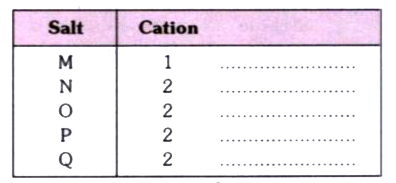Potassium chloride is added to water and stirred. A salt solution is obtained which is then boiled leaving behind a residue.
Are the composition and properties of the original substance altered
To determine whether the composition and properties of potassium chloride (KCl) are altered when it is added to water and then boiled, we can analyze the process step by step.
1. Identify the Original Substance: The original substance is potassium chloride (KCl), which is an ionic compound in solid form.
2. Dissolution in Water: When potassium chloride is added to water, it dissolves. This process involves the ionic bonds in KCl breaking apart, resulting in potassium ions (K⁺) and chloride ions (Cl⁻) being surrounded by water molecules. The resulting mixture is a salt solution.
3. Formation of Salt Solution: The salt solution is a homogeneous mixture of water and dissolved KCl. At this point, the physical state of KCl has changed from solid to dissolved ions in a liquid.
4. Boiling the Salt Solution: When the salt solution is boiled, the water begins to evaporate. As the water evaporates, the concentration of KCl in the solution increases until all the water has evaporated.
5. Residue Left Behind: After boiling, what remains is a solid residue of potassium chloride (KCl). This means that the KCl has returned to its original solid state.
6. Comparison of Composition and Properties: At the beginning of the process, we had solid KCl, and after boiling the solution, we again have solid KCl. The composition (K⁺ and Cl⁻ ions) and properties (such as solubility, melting point, etc.) of the original substance have not changed.
7. Conclusion: Since we started with potassium chloride and ended with potassium chloride, we can conclude that the composition and properties of the original substance were not altered during the process. The changes observed were purely physical (dissolution and evaporation) and did not result in a chemical change.
Final Answer:
No, the composition and properties of the original substance (potassium chloride) were not altered.
---
No, the composition and properties of the original substance (potassium chloride) were not altered.
Topper's Solved these Questions
- PHYSICAL & CHEMICAL CHANGESBOOK - ICSECHAPTER - PHYSICAL & CHEMICAL CHANGESEXERCISE - OBJECTIVE TYPE QUESTIONS (Physical & Chemical Changes)
21 Videos
- MATTERBOOK - ICSECHAPTER - MATTEREXERCISE - EXERCISE (J. Short answer questions)
5 Videos
- PHYSICAL AND CHEMICAL CHANGES BOOK - ICSECHAPTER - PHYSICAL AND CHEMICAL CHANGES EXERCISE - Think and answer
4 Videos
Similar Questions
Potassium chloride is added to water and stirred. A salt solution is obtained which is then boiled leaving behind a residue.
Is the change reversible or not reversible
View SolutionPotassium chloride is added to water and stirred. A salt solution is obtained which is then boiled leaving behind a residue.
Is the above change physical or chemical
View SolutionPotassium chloride is added to water and stirred. A salt solution is obtained which is then boiled leaving behind a residue.
Name the residue which remains behind after the salt solution is boiled
View SolutionPotassium chloride is added to water and stirred. A salt solution is obtained which is then boiled leaving behind a residue.
Give a reason why the above experimentation would not be possible, if calcium carbonate is taken, in place of potassium chloride.
View SolutionState which of the following pertain to - chemical changes.
The composition and properties of the original substance are not altered.
View SolutionA ______ change is a permanent change in which the original substance loses its own composition and properties.
View SolutionFeC3 is added separately to excess of boiling water and excess of NaOH solution, the sols obtained contain respectively the disperse particles to be :
View SolutionWhen chlorine water is added to an aqueous solution of potassium halide in the presence of chloroform, a colour is developed but on adding more of chlorine water the colour disappears, and a colourless solution is obtained.This test confirms the presence of the following in aqueous solution.
View SolutionWhen diemethyl glyoxime is added to the aqueous solution of nickel (II) chloride in presence of dilute ammonia solution, a bright red coloured precipitate is obtained .
(a) Draw the structure of bright red substance .
(b) Write the oxidation state of nickel in the substance and hybridisation.
(c ) State whether the substance is paramagnetic or diamagnetic.
View SolutionSalts M, N, O, P and Q undergo reactiom (i) to (v) respectively.
Identify the cation present in these salts on the basis of these reaction. Tabulate your answer in the format given below.
1. When sodium hydroxide solution is added to the salt M, and heated strongly a colourless gas with a pungent smell is evolved which turm red litmus paper blue and gives dense white fumes with a moist glass rod with hydrochloric acid.
2. Addition of dilute hydrochloric acid to a solution of N gives a thick white precipitate which is soluble in hot water.
3. When ammonium hydroxide solution is added to the solution of 0 a light blue precipitate is obtained which is soluble in excess of ammonium hydroxide to form an inteme deep blue solution.
4. When ammonium hydroxide solution is added to the solution of P reddish brown (mustard colour) precipitate is obtained which ,is insoluble even in the excess of ammonium hydroxide solution.
5. When sodium hydroxide solution is added to the solution of Q a which coloured gelatinous precipitate is obtained which is soluble in excess of sodium hydroxide to form a clear solution

View Solution
